The Sweet Life at Muddy Pond Sorghum in Tennessee & a Recipe for the Best Sorghum Cookies
In 1965, John and Emma Guenther moved from Pennsylvania to Tennessee. John, a Lowland Dutchman, from Saskatchewan, Canada, began making sorghum as part of a community effort. At the time, many of the families in the area raised sorghum cane and made syrup together. In 1981 when the rest of the community stopped growing sorghum cane, John began planting and harvesting his own crop. Today, the Guenther family collectively owns thousands of acres. They raise livestock and other crops on their farm. Sixty acres are planted in sorghum. Four out of eight siblings in the Guenther family, their children, and extended family are involved in Muddy Pond Sorghum, however, Mark and Sherry Guenther are the two spokespersons for the business.
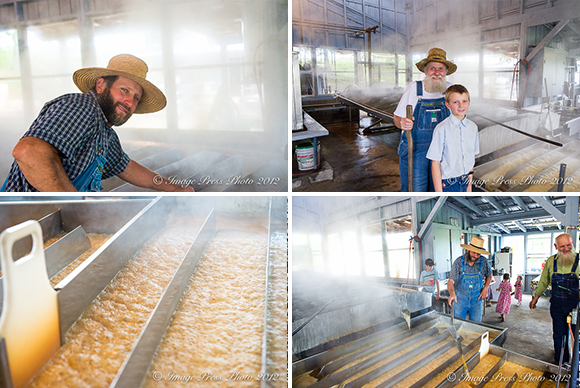
Family and friends of the Muddy Pond community work at the mill
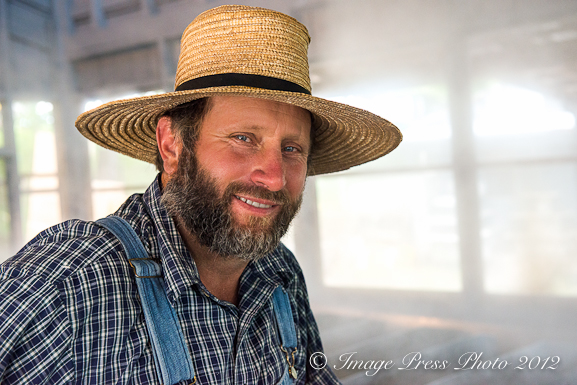
Mark Guenther
As most teenagers, Mark was not initially interested in the hard work that it took to turn sorghum cane into syrup and chose “public work” over the collective family effort. In a short amount of time, Mark realized that the life at Muddy Pond and sorghum making was in many ways better than life outside the community and returned to the fold. He used his skills and talent to build equipment that would automate much of the process and make it easier to cut, juice, and boil the sorghum. Tractors with cane harvesters and built-in mills, pressurized boilers, hydraulic lifts, and pumps have replaced most of the manual effort.
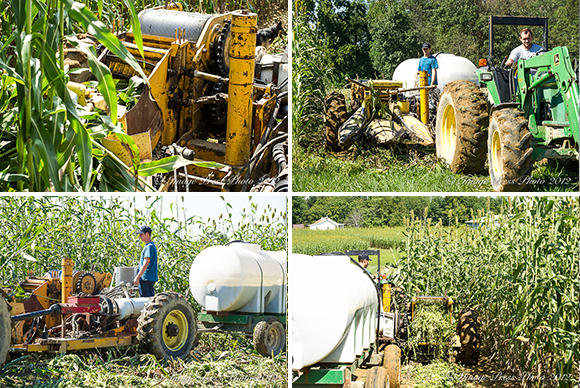
Modern equipment has made harvesting the cane easier
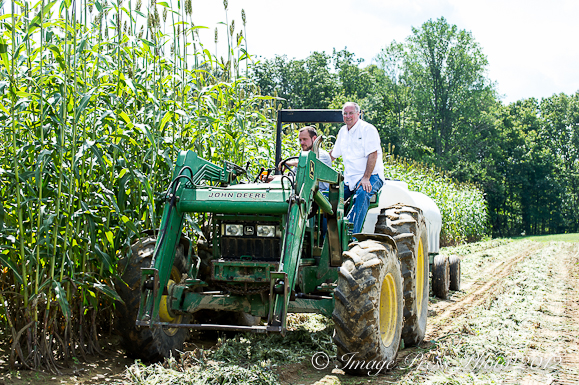
Mr. B relived some of his life on the farm with family in Indiana with Ed Guenther

The seed pod from the cane
The original process of extracting the juice was with a horse-drawn mill, which a few sorghum makers still use today, primarily for demonstration purposes. The extracted cane juice was cooked over an open flame in a large pot or cauldron until it was reduced to a syrup. Because this method was inefficient for making large amounts of sorghum, many producers have developed their own unique methods for sorghum production. This video shows the process Mark and his family invented at Muddy Pond from harvesting the cane in the fields to the bottling at the mill.
Mark and Sherry spend much of their time traveling to festivals and other events with their horses and mules where they demonstrate traditional sorghum making. They have attend the Southern Foodways Alliance Taste of the South gathering at Blackberry Farm each year, dined with the governor of Tennessee, traveled to the Atlanta Food and Wine Festival, and made their way to Washington, D.C., to accept the American Treasures Award. “We are so blessed. Sherry loves it. It is in her heart and soul. We are so happy to go to these places,” Mark told us. Asked if they ever have time for a real vacation, Mark said that these trips are their vacation, however, “It would be nice some day to go somewhere where no one knows who you are and not make a big deal about it.” That probably will not happen any time soon as the popularity of sorghum continues to grow.
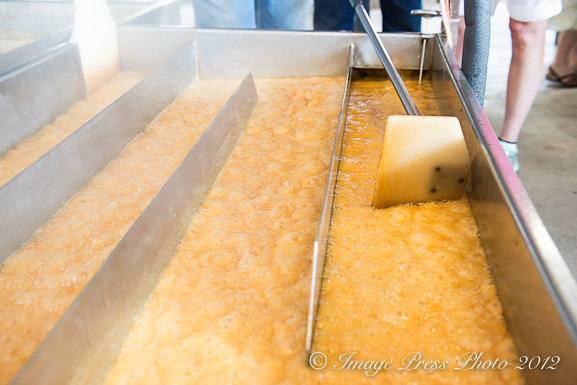
Sorghum boiling down in the finishing pan
The laborious work of the fall harvest is not the end of the hard work for the Guenther family. Everyone has their chores as winter comes and the old sorghum crops are plowed back into the ground. Cover crops will be seeded. Cattle and mules move inside the barns as chilly temperatures creep into the Tennessee foothills. Next spring, as the new crop will be planted the first of May, the manure from the barns will be spread to naturally fertilize the fields.
The Guenther’s most successful sorghum crop to date was this year, 2012. While other parts of the country suffered extreme temperatures and drought, sorghum is a hearty crop. It can also grow in very poor soil. “It’s very resilient,” Mark said. “Until July, it was hot and dry. We were discouraged, but the sorghum cane stands back and waits. t matures over fourteen to twenty days. The rains came and it grew. It was unbelievable. It’s one of our best crops ever. Of course, it’s not done until it is in the jars.”
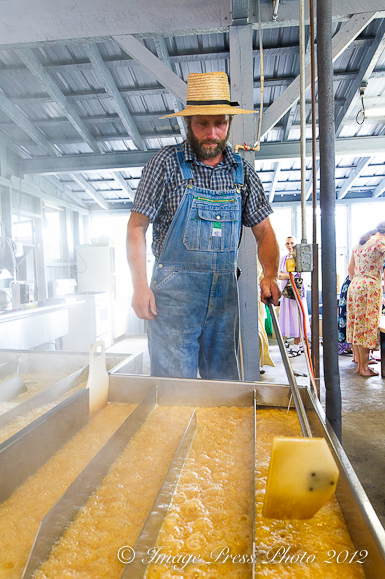
Foaming sorghum syrup just before it drains into a bucket
















What a contrast it must have been after being at Muddy Pond, and then returning to the furor of business that is Atlanta! Thanks for sharing your experience, Gwen!
I have not purchased their sorghum before, but I will look for it, now, next time I’m at Whole Foods.
Hi Susan,
Yes, Atlanta seemed rather frantic after being in such a peaceful environment for a day. It really was an exceptional experience.
Gwen
I only buy Muddy Pond, am member of SFA, and attend events at Blackberry Farm, as we also have property near Walland, Tennessee. A wonderful post on a special family and their business.
A wonderful article. Such an, “insider”, view of the crop and processing. We will certainly be trying to get our hands on some Muddy Pond, Sorghum. Such an important and old grain. I think it sounds good for a meat bbq sauce or glaze as you suggest. A lovely look at Muddy Pond and its families.
I am so glad to see the Guenther family getting recognition for their hard work, producing such delicious sorghum. I’ve never met a harder working family than the Guenthers! Their sorghum is wonderful in so many recipes, that it’s hard to decide which is my favorite!
Mark kindly took time out of his busy day to give me a tour of the Muddy Pond Sweet Sorghum fields and processing area a couple of years ago when I came to America for a conference.
What a delightful experience.
Mark has to be one of the nicest people on all of Planet Earth and the sweet sorghum syrup they make at Muddy Ponds is every bit as wonderful as Mark’s good nature. If everyone in the world would learn to live like the folks at Muddy Ponds, the world would be a FAR better place!
Thank you Mark and everyone at Muddy Ponds. I only wish we were able to get more of you sweet sorghum here in Australia.
Keep up the great work folks. Think of you often and fondly!
Best wishes,
Rob Smallwood
Sydney, Australia
So nice of the family to share a part of them with all of us. Muddy Pond sounds like a wonderful place to be. I will definitely order some of their product and make these cookies.
I’ll have to see if our local markets carry their sorghum here in Knox, Three Rivers might. Southern Living just did a piece on sorghum this month and I was wanting to make the sorghum beef ribs in my smoker this weekend.
Excellent post, I enjoyed the read.
I loved this post Gwen. So touching and so very interesting. I have not seen their sorghum, but I will now seek it out at Whole Foods as I would like to incorporate this into some of my products. Especially interested in a Sorghum sweetened jam 🙂 Your photos really captured the heart and feel of your visit.
Gwen, this is utterly fascinating! As you say, many of us don’t know how sorghum is made, or really know much about it at all, but what I find so interesting is the whole way of life of this family and community business. Which is so much more than just a business. You were so lucky to be able to go, discover and spend time at Muddy Pond.
I’ve seen sorghum on labels but thought it was some kind of chemical additive. I’m please to know it’s a natural sweetener. I had no idea. Thanks for the education and great storytelling.
Beautifully done – Bravo, Gwen! I just went back in time…and I wish I could move there and live simply (with my tooth, I just might fit right in..lol JK!), making sorghum – no SEO..no meanies..just a simple life. Loved the video, and as usual, the photos make me feel as if I was there too. When I was in NC around the age of 13, I had a biscuit with butter and sorghum. I will never forget how amazing it was. Maybe I can recreate it with Mark and Sherry’s sorghum, soon!
So beautiful, Gwen. Thank you for sharing this special family and what they do with all of us!!
love this article,
My family is from Muddy Pond, and I know they’re proud to see it’s much like it was when they were growing up.
A group of people still willing to come together as a community.
Lets hope it stays this way forever!
Pingback: Muddy Pond Sorghum Syrup | Three Rivers Market
I just made the cookies you describe above using sorghum I harvested and processed this year (my first time ever!) Thanks so much for a nice article and a great recipe!
Pingback: Sorghum Cookies | My Home Among The Hills
I missed seeing you at The Museum of Appalachia this year. I always buy my sorghum there.
Pingback: A Family Sorghum Business | Business To Your Management
This farm belonged to my grandparents. My mom grew up in the original farm house, that I am sure has been torn own by now. My brother visited the farm back in the 70’s. I am so glad to know that the farm has prospered and made a good living for these people.
PS. My mom was a Phillips, not sure if my grandfather sold them farm or his daughter’s family, the Englands
Blessings to all ~ I am ordering a jug of sorghum today!!.
I have really enjoyed this article! We just moved to west Tennessee (from WV) two years ago. One of our young ladies from church is getting married and is having cookies at the reception. She asked me to make ginger spice cookies, which I had never made. Since the recipes called for molasses (and I did not have any), I searched to see if I could use sorghum…a man from church had given me some. When I found out I could, I started searching for recipes using sorghum and found this recipe, Best Sorghum Cookies. I was so excited to find it! My father is from Crossville, TN…I am not sure where that is in relation to your location, but I thought nearby. I was raised in northern OH, but when our family returned to Crossville to visit grandparents, my dad always brought home sorghum. I made this cookie, and it is perfect! I wish my dad were here to taste them!! Thank you for article and recipe! I hope to visit sometime!
Hi Beth,
Thank you so much for your comment. I’m glad you found the article and recipe and enjoyed the cookies. They are delicious.
We live in Atlanta, but Muddy Pond Sorghum is located about 23 miles from Crossville. If you are in the area during sorghum making season, it would be worth a visit to meet the Guenther’s, see the sorghum making process, and buy a jug of sorghum while you’re there. 🙂
Best,
Gwen
I enjoyed the read on Muddy Pond Sorghum. I just made the sorghum cookies and they are chewy delicious cookies. I absolutely loved cooking with an ingredient new to me (sorghum) and learning some history behind it. Recommend others trying the recipe out.
Hi Lisa,
I’m glad you enjoyed the recipe and the story of Muddy Pond sorghum. Thank you for taking the time to leave a comment.
Best,
Gwen